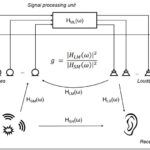One of the most common questions that you will hear in active room acoustics is: “what would be the best reverberation time for my room and how do I get there?”. The counterquestion needs to be: “what do you want to do in your room?”. And therein lies one of the common problems for room […]
Various
The sound of absorption – an experience!
How would you explain the experience of good sound absorption in a room? To truly understand the value of better acoustics you need to experience it firsthand. This is why we have built two identical rooms with different absorption in our showroom Ecorama at the Ecophon headquarters in Hyllinge, Sweden. Here you can experience the […]
Classic Acoustics and Psychoacoustics – Similarities and Differences
Right after the grand opening of EIAS 2023, it was time for Alice Hoffman Senior Acoustician, PhD from Brekke and Strand, to make her entrance. She took us on a journey to see how Classical Acoustics can be compared to Psychoacoustics. Her own thoughts on this are that it often seems to be a lot […]
New Finnish acoustic standard paves the way
Finland paves the way for clear and science-based guidelines worldwide, with its revised standard for acoustic environments in buildings. Developed by the country’s leading acousticians, the standard is established in the business and among policymakers. In 2017, Finland’s Ministry of the Environment issued a decree on the Acoustic Environment of Buildings. Several parts of the […]
“Find your Quiet Place” campaign – SoundPrint strives to make the world a quieter place
SoundPrint has a user-based community who play a vital role in raising noise and hearing health awareness through their “Find your Quiet Place” campaign, sound level measurements in visited venues. Late last year, SoundPrint’s second annual “Find Your Quiet Place” (FYQP) Challenge concluded and data gathered makes interesting reading. The campaign inspired participants to measure […]
Additional acoustic treatment in a bank hall – a case study.
Excessive noise levels can be a significant distraction while trying to talk to a client, and it can make it difficult to hear and understand what the other person is saying. It can also be frustrating and stressful for both the client and the bank employee. In addition to being a distraction, excessive noise level […]
Digital design and acoustics at the School of Architecture
The iterative process of professionals providing expertise to the design students, using a file-to-factory approach and continual feedback, proved an effective way of learning and producing fast and high-quality prototypes at the School of Architecture, Sweden. Collaboration between architects and acousticians, and between designers and other specialists In line with our continued effort to raise […]
The issue of invisible sound, commentary by acoustician Daniele Ponteggia
Acoustics means beauty…but why is so much ugliness still around? Today there is a high possibility that you walk into a fancy restaurant, gym, swimming pool, museum, or sports hall and experience all kinds of acoustical defects. I often think about how architects, designers, and even landlords do not consider acoustics. Sometimes things are planned […]
Soundscape Attributes Translation Project (SATP)
The following article on the SATP project courtesy of Dr. Francesco Aletta, at UCL via Ph.D. Candidate Ela Fasllija at Bilkent University. Soundscape Sounds in cities and built environments are often measured as noise in terms of decibel levels. Yet the human perception of soundscapes is often overlooked. Soundscape opens up the possibilities of managing […]
Baltic-Nordic Acoustic Meeting 2022
On May 9-11 2022, Aalborg hosted the bi-annual Baltic Nordic- Acoustic Meeting (organized by the Nordic Acoustic Association), which this time is merged with the EUROREGIO (organized by the European Acoustics Association). The conference brought together academics, engineers, consultants, and other practitioners in the wide field of acoustics. Some of the really interesting presentations are […]











